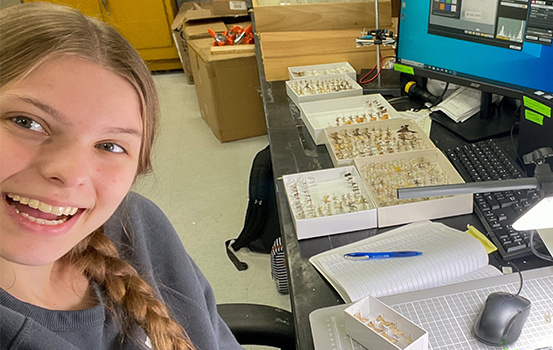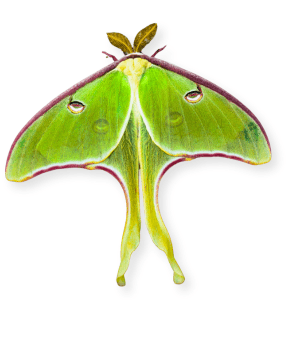What started as a hobby taking photos of butterflies at a community garden gave Allie Fletcher a jumpstart to a future in ecology research. Now, she’s helping build one of the largest single-site insect databases in the country, while discovering and identifying species never documented in South Carolina.

Fletcher discovered her passion for the environment when she enrolled in Eric LoPresti’s insect ecology course, where a trip to USC’s Green Quad sparked her interest in photographing the local fauna.
LoPresti noticed and invited Fletcher to take photos for his insect research project.
That invite turned out to be the push Fletcher needed to expand her academic focus, adding environmental studies to her existing chemistry major. She’s now working in LoPresti’s research lab, assisting on an insect databasing project that will help researchers track the way climate change has impacted South Carolina.
Butterfly effect
Lo Presti, a researcher in the Department of Biological Sciences, and his team are resuming the work that a local citizen scientist started nearly 60 years ago.
Richard B. Dominick, a decorated Marine Corps aviator and ophthalmologist by trade, was a hobby lepidopterist – insect enthusiast – who in 1965 started collecting moths and butterflies on his property in Charleston County. The nearly 30,000 moth and butterfly specimens he identified now reside in the Biological Sciences Department at USC.

In just over a decade, Dominick put together one of the most complete moth collections in the country, and LoPresti is picking up where Dominick left off. By adding to the collection, Lo Presti and his team will eventually be able to show how species in SC have changed over the last half century.
“We know that the world is changing, and insects are declining worldwide,” he says. “To be able to see community changes because we have this historical dataset from the same location is a unique opportunity.”
From local to global
The collection process is relatively simple, using blacklights to attract the insects, nets to catch them and buckets to collect them. LoPresti and his team collect several times a month, sampling from the diverse habitats of the area.
When the specimens arrive at USC, Fletcher and the others in LoPresti’s lab identify, pin and photograph each one. Duplicate species are sometimes sent to other labs at USC and partner institutions.
Lo Presti says when the team no longer finds new species in the field, they’ll know the collection phase is complete. He estimates the research will continue for at least the next five years, and the data will yield insights into the impact of ecological changes.
The team has already made some important observations about the habits of the insects in that area. They found that 60 percent of moth and butterfly species emerge as adults earlier in the year and have a longer flight season than during Dominick’s day.
Fletcher says this can lead to significant effects on the local food web.
"Birds or bats may feed their young off of primarily caterpillars, but if the adults have already turned into butterflies or moths, then there aren’t caterpillars around,” she says. “That leads to big implications for the system as a whole.”

And that isn’t the only discovery the researchers have made. Since collection began in fall of 2022, the team has already identified at least 10 new species that are not present in the Dominick collection and at least five that have never been seen in SC.
Several of the species are typically found in Florida and Georgia. LoPresti says this points to northern range expansion, meaning the insects are expanding toward cooler climates.
These observations align with research findings from other regions of the world that show certain insects are emerging earlier and flying for longer, adding extra generations of insects into the breeding cycle.
“Seeing the sheer diversity of moths that are in one place at one time is stupendous,” LoPresti says.”
“We are excited to see what this data will show us not only about the region where we are collecting but also in understanding the impact of ecological changes globally.”
